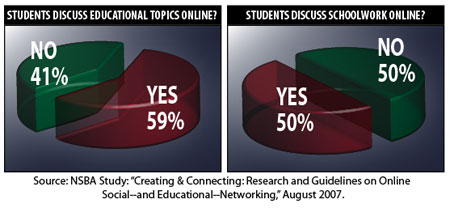
Karl Kapp is an expert in the education and e-learning field. In his blog, he regularly answers questions and addresses concerns about the place of technology in educational and training scenarios. In this post, he follows up on three areas of concern that he has been made aware of in recent times. In this post, I’ll address the same questions and expand upon Kapp’s answers.
1) Kids use these “places†like Second Life, Facebook, etc. mostly for socialising.
Students are just as likely to be discussing education or school work as they are to be gossiping, chatting or otherwise passing the time socially when they are using digital social networking tools. These include mobile phones, web-based solutions such as Facebook and its ilk, and the digital environments like Second Life.
This study, completed back in 2007, provides compelling evidence to support this idea. Over a thousand 9-to-17 year olds, a thousand parents and 250 school district leaders who “make decisions on Internet policy” were polled in the study. It revealed that 59% of students discuss educational topics, and 50% of students discuss their coursework when using the wide variety of digital social-networking tools available. Apparently, this academic discussion is performed off their own bat to a large extent, rather than being a required part of their schooling.
Students today have a multiplicity of such tools to choose from when wanting to communicate with their fellows locally and at a distance. Students who would otherwise be somewhat isolated except for family after school, at the time they are doing their homework, and who would be limited for the most part to communication with people who are geographically proximate, are now able to easily contact and communicate with people who are not only from all over the world, with wide-ranging backgrounds. Students have plenty of educational reasons to reach out through these channels. Socially, there is less call to do so, as students are able to communicate with their fellow students and friends face-to-face and on the phone. What is the likelihood that students are talking about the same stuff they’ve always talked about, and are just using digital tools to do so?
Despite the wonderful news that students are eager to further their own education and support themselves in their coursework through external communication, there is the continuing problem that services available to 9-to-17 year olds are quite restricted. This is in part to protect kids in this age bracket from “adult themes” which are not appropriate for them, and in part to prevent misuse by students. Preventing misuse of services requires greater supervision of kids in general than most educational institutions have the resources to maintain. Nonetheless, educational materials and tools have always been at risk of problematic use – should the majority of students who would use them responsibly be denied because of the actions of the minority?
2) Currently, it seems that much of the Second Life work is more about SL itself — how to use it, what you can do, etc. — rather than the actual educational effectiveness.
Essentially, it is common for new technologies to take in the order of a decade or more to become sufficiently well understood that they can be used as educational tools on a grand scale, unless they have numerous and active advocates. Digital environments and their capabilities are as yet poorly understood, even by the majority of current users, and there is as yet a paucity of data available that gives us any idea as to how effective digital pedagogies have been to date.
3) Much of educators’ enthusiasm falls short of the mark by deferring to what could be called the “You can…†syndrome. That is, the endless possibilities inherent in a system are the source of excitement, but get nailed down in very few instances.
Some of the excitement is bound up in misunderstandings about how tools can be used – it’s exciting to imagine that a new tool is the solution to many, many problems. It’s possible to let the imagination reign, up to the point at which you discover the limitations of the tool you are working with. At this point, some of the excitement fades, and it’s difficult to maintain the same enthusiasm once the hard work begins. Additionally, as with the point above, more testing and trials need to be performed and more data needs to be gathered before solid instances and use cases begin to appear.
If students are let somewhat looser in digital fields than they have been, it would be interesting to gather information on how the students leverage these technologies to further their own education – students make great teachers and leaders.
Speak Your Mind